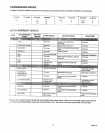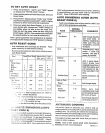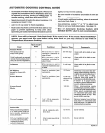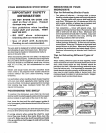
MUCROW VIiHG TiiP$
• Make sure all cookware used in your microwave oven
Is suitable for microwaving_ Most glass casseroles,
cooking dishes, measuring dishes, measuring cups,
custard cups, pottery or china dinnerware which doe_
nol have metallic trim or glaze with a metallic sheen cap
be usec Som_ cookware ts labete_; 5uitabie in:
t,;yo_Ja,'_ not sure it a dish is microwave-sa1_, use titi:
_ast: P._acein the microwave oven both the dish you ar_
_._stit_._.3r_:._a glass measuring cup filled with one cup e_
wa_et. Set the measuring cup of water either in or next
ia the dish. Microwave 1 minute at High power, if the
di_t_ heat_, tt should not be used for microwavlng° tf the
dish remains cool and only the water in the cup heats,
lhen the dish is mlcrowave-safe.
, P_per towels, wax paper and plastic wrap can be used
i,oco}er dlshes in order to retain molsture and prevent
spatterttlFj. Be sure to vent plastic wrap so steam can
escape.
• Som_, mlcrowaved foods require stirring, rotating or
rearrangh_g Check the cookbook.
• _team builds up pressure In foods which are tightly
cowred by a skin or membrane. Pierce potatoes, egg
yolks and chicken livers to prevent bursting.
COOKWARE FOR SHELF H &T NG
R HF=AT NG
Before placing food in dishes to cook using your
m_crowave oven shelf, check to see if the dishes will fit
[og_[her on or under the shelf, Also, be sure cookware
is microwave-safe,
Cookware Ior heating or reheating Includes a 1-cup
measuring cup, 9x5x3-1nch loaf dishes or 9-inch pie
plates,
Leftovers may be placed in small individual ceramic or
plastic bowls or divided plates.
Use wax paper or plastic wrap instead of lids on
casseroles. Lids may add too much height to dish.
AUTO ]ATaC CO0 I G
COHTA_H_._ A_D COVERS
Appropriate containers and coverings help assure good
cooking results.
Aiw_ys use microwave-sale containers and cover
them witl_ lids, wax paper or plastic wrap. Wonder It
it's microwave safe? Put It to the test described in
Microwave Cooking Tips.
Never use tight-sealing plastic c0vers--they can
prevent steam from escaping and cause food to
overtook,
, Matchtheamountoffoodtolhesizeoflhecontalnero
Fill containers at least half fullo
Be sure the outside of the cooking container and the
inside of the microwave oven are dry before placing
food in the oven. Beads of moisture turning Into
steam can mislead the sensor_
• Stir or rotate some foods after a beeping signal. See
Automatic Cooking Control Guide.
Use microwave-safe casseroles or bowls for entrees
and vegetables, Cover with llds that fit. If lids are not
available, use plastic wrap or wax paper. Plastic wrap
should be loose over food to allow for expansion. Seal
by pressing plastic wrap firmly around edges.
For frozen entrees in paperboard trays, remove tray
from box but do not remove film over tray. Thick entrees
may take longer to cook--see guide on page 15.
Forfrozen foods in metal trays, remove 1ollcovering and
baked goods, re.insert tray into box and close ends of
box.
Slit plastic pouches 1 inch as shown above. Break food
up thoroughly after oven stgnals_
Use oblong or square containers for chicken or corn on
the cob. Plastic wrap covering should be loose over
food to allow for expansion, Seal by pressing plastic
wrap firmly around edges.
Paper plates--while they may be used for Time and
Temperature Cooking and Defrosting, do not use them
with automatic cooking. Use mlcrowave-safe plates or
bowls for reheating. Cover with plastic wrap c_"wax
paper.
Follow Automatic Cooking Control Guide setting for
casseroles. Cover casserole meat and vegetables with
sauce. Cool hot ingredients or sauces. If they are not
cool, use TIME COOK.
17 NEMIC20


















